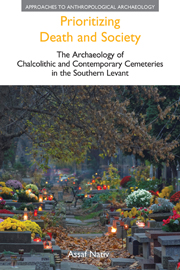 Prioritizing Death and Society
Prioritizing Death and Society Book contents
- Frontmatter
- Dedication
- Contents
- List of figures
- List of tables
- Acknowledgements
- Part I Introduction
- Part II Chalcolithic cemeteries
- Part III Contemporary cemeteries
- 10 An archaeology of us
- 11 The raw materials: from matt to lustre, from grey to colour
- 12 Tombstone morphology: communal trajectories
- 13 Tombstone elaboration: personal expressions
- 14 Spatial patterns: between institutional policy and interpersonal spontaneity
- 15 Intersecting discourses
- Part IV Conclusion
- Appendix: Gazetteers of cemeteries
- Notes
- Bibliography
- Index
12 - Tombstone morphology: communal trajectories
from Part III - Contemporary cemeteries
- Frontmatter
- Dedication
- Contents
- List of figures
- List of tables
- Acknowledgements
- Part I Introduction
- Part II Chalcolithic cemeteries
- Part III Contemporary cemeteries
- 10 An archaeology of us
- 11 The raw materials: from matt to lustre, from grey to colour
- 12 Tombstone morphology: communal trajectories
- 13 Tombstone elaboration: personal expressions
- 14 Spatial patterns: between institutional policy and interpersonal spontaneity
- 15 Intersecting discourses
- Part IV Conclusion
- Appendix: Gazetteers of cemeteries
- Notes
- Bibliography
- Index
Summary
Although the tombstones populating the fairly desolate landscape of contemporary cemeteries in Israel may strike one as variegated, the range of forms is quite limited. Grave markers consist of two basic components, erected on a concrete infrastructure: a low, box-like structure that superimposes the backfilled pit, to which an appending element is often added, attached above it at one of its ends. Although the height and size of the lower part may vary, it is the form of the upper part that shows the greatest diversity.
Generally speaking, the tombstones may be divided into two types: vertical and horizontal. The former have an erect stone slab, while the most conspicuous aspect of the latter is the elementary box-like structure. These two types may be further subdivided according to the presence, absence and form of the appending stone. Thus, the vertical tombstone consists of four recurring variants, according to the particularities of the standing stone's form (see Figure 12.1):
type 1 — a rectangular slab set up vertically;
type 2 — the same as type 1, but with a curved upper part instead of an angular one;
type 3 — the same as type 1, but with a small arched segment on top;
type 4 — usually an elongated slab in front of which two columns are set up, supporting a roof-like element.
- Type
- Chapter
- Information
- Prioritizing Death and SocietyThe Archaeology of Chalcolithic and Contemporary Cemeteries in the Southern Levant, pp. 156 - 166Publisher: Acumen PublishingPrint publication year: 2013
